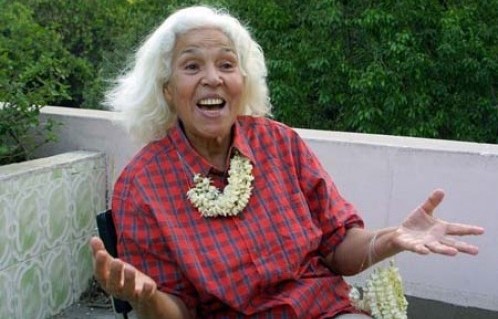Nawal al-Saadawi: Writer or Politician First?
 Earlier this week, Egyptian author and activist Dr. Nawal al-Saadawi told BBC4 that she is at work on a new novel. When asked if the new novel would reflect events in Tahrir Square at the beginning of this year, Dr. al-Saadawi said:
Earlier this week, Egyptian author and activist Dr. Nawal al-Saadawi told BBC4 that she is at work on a new novel. When asked if the new novel would reflect events in Tahrir Square at the beginning of this year, Dr. al-Saadawi said:
“Of course. I became a different person, and a better human being. … I will describe how in Tahrir Square, we lived a dream, in which we are equal.”
Al-Saadawi is in London this week to celebrate her upcoming 80th birthday. She received a UK “Women of the Year Outstanding Achievement” award on Monday, and will be appearing at the Frontline Club today to discuss her work.
Al-Saadawi has been far more involved in political activism than in Egypt’s literary development, but she has found time to publish 11 novels, eight short story collections, several plays, memoirs, and other works of non-fiction. More than two dozen of al-Saadawi’s works have been translated into English, most published by al-Saqi or Zed Books. This may well put her at the most well-translated author (in English) after Naguib Mahfouz.
And I ask this very naively: Why does she let Zed put covers like these on her books?
Her most well-known and powerful works are probably Woman at Point Zero, God Dies by the Nile, The Hidden Face of Eve, Memoirs of a Woman Doctor, and Memoirs from the Women’s Prison.
Although she has seen a great deal of life here in Egypt (hesba cases and all), Al-Saadawi’s work has in many ways had a greater impact in the West. Juliet O’Keefe wrote in 2008, in Dissent Magazine, aboutThe Hidden Face of Eve: “For me, as for many other young (white, North American) feminists in the early 1980s, the horror of genital mutilation, of which we had largely been ignorant, overwhelmed us, and – and I say this carefully – fixed to an unfortunate degree our opinions on women’s situation under Islam.”
I will note, as O’Keefe does, that FGM is practiced in many African countries (of which Egypt is one), and is not a specifically “Islamic” practice. Nor did al-Saadawi ever claim it was a Muslim practice, I don’t think. But O’Keefe notes “we took from the book a one-dimensional afterimage of the Arab woman as wholly victimised and held under the thumb of a rigid, ahistoric theocracy.” I guess I can be glad that, in the 1980s, I was still a young, pale-skinned primary-school student.
O’Keefe adds that, for her and others, “El Saadawi was seen as anomalous and isolated, granted the position of singular representative for Arabic women….”
Al-Saadawi’s role in this re-presentation is not entirely clear (to me). O’Keefe adds that the publisher certainly had a part:
But it is difficult not to read some conscious manoeuvring, awareness of audience, into other changes made between the Arabic original and the English text (documented exhaustively by Amal Amireh) which include the foregrounding of the issue of genital mutilation at the expense of political material; the harrowing opening of the book, describing El Saadawi’s own experience of circumcision, was situated differently in the original, and less sensationally.
You can also see the covers above. It is difficult to understand quite how al-Saadawi would have agreed to them, although I say that having heard other authors furious at their exoticizing covers and introductions.
Al-Saadawi’s novels have often been criticized as mere vessels for her political messages. They certainly do have a message, and sometimes the literary joy is ossified by it. But elsewhere the writing is direct, clear, and lovely.
Amal Amireh wrote, in Al Jadid, that “I agree that el-Saadawi is popular in the West partly because her works have played into Western prejudices. But I don’t think this fact should be merely used to dismiss her achievement.”



You must be logged in to post a comment Login